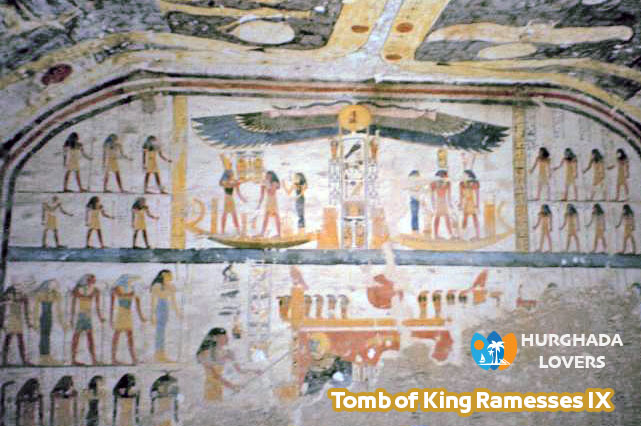Tomb of King Ramesses IX “Ramses” in the Valley of the Kings, Luxor, Egypt | Facts KV6 & History Building Pharaonic Tombs in the 20th Dynasty and more about Cemetery Design and Decoration, Entry Ticket Prices.
Facts and history of building pharaonic tombs in the ancient civilization of Egypt, the twentieth dynasty and more, the design of the cemetery, the dates of the visit, the prices of admission tickets…
It is a tomb located in the Eastern Valley in the Valley of the Kings in Egypt. The tomb shows signs of speedy implementation due to the death of King Ramses IX before its construction was completed. Learn more about the tomb below.
Hurghada lovers Offer Luxury Hurghada to Luxor Tours | El Gouna to Luxor Tours | Makadi bay to Luxor Tours | Sahl Hasheesh to Luxor Tours | Soma bay to Luxor Tours.
Tomb of King Ramesses IX
• King Ramses IX is the eighth king of the 20th dynasty, and he ruled Egypt for 18 years.
• The period of the king’s rule was somewhat difficult, as the country was suffering, both economically and politically.
• Perhaps this is a strong reason for not completing the construction of the cemetery during the reign of the king.
• There is even evidence that the cemetery was built at intervals.
• Perhaps this is due to the high costs of constructing the tomb and the failure of the royal court to bear such expenses.
• The cemetery comes with a set of inscriptions, and it also comes with a rather high surface, and thus differs from the rest of the tombs that come in the same era.
• A range of colors were used, including black and blue, as well as yellow, which are unusual colors in the remaining tombs of the Valley of the Kings.
• Most of the tomb’s contents were stolen, including the king’s sarcophagus, and it has not been found so far.
Inside the tomb of Ramses IX
• The corridor, which was named “B” corridor, contains a wide range of scenes, including the king’s standing before the god Ra and Osiris.
• There are also other pictures that were drawn very accurately, even showing the details of the clothes, as well as an official of a cobra with a lion’s head, which is a sign of authority.
Cartouches were also found, as well as a text from the Hymn of Ra, a hymn used in prayer to praise Ra.
• There are also other drawings that refer to the priest named Yoon purifying Osiris and performing the ritual of opening the mouth.
• On the right wall of the corridor there is a picture of the king standing before Amun-Re and offering him incense.
• The king came wearing a fully painted crown.
• On the northern wall, there is a group of appearances that came in the first part of the Book of Caves, which is a funerary book.
Corridor C in the tomb of Ramses IX
• There are inscriptions on the northern wall, including the Song of Ra, in addition to part of the Book of Amduat, which is also a funerary book.
• At the bottom of the wall comes a picture of King Ramses IX as he advances to his tomb with the god Hathor, which holds a large plaque bearing the names of the king.
• There is also another image of the king worshiping in front of Khonsu and Neferhotep, while on the right wall there is a snake and a god with a ram’s head.
• On the ceiling are detailed drawings of the polar stars, which are colored yellow.
• There is a gate at the end of the room in the corridor above which there is another picture of the king with his family during their worship.
Corridor D in the Tomb of King Ramesses IX
• An inscription was made on the wall of the corridor of the second and third hour of the Imidawat Book, but it appears in an abbreviated form.
• On the right there is a picture of King Ptah and Maat, and there is also a picture of the king in the image of the god Osiris.
• What is meant by the previous picture is the equality between the king and the god.
• Then comes the room called Room H, which contains another set of inscriptions, including a picture of Priest Yoon and Priest Motif.
• The burial chamber comes inside the cemetery and contains a group of excerpts from the Book of the Earth, which were inscribed on the right and left walls.
• Pictures were also found explaining the journey during the day and night by the king using solar boats, and on the left there is a picture of a group of gods.
• There is also another picture of the king standing in front of a decorated shrine.
• The ceiling of the burial chamber was engraved with images of the goddess Nut and also the sun disk crossing her body at night.
• There is also a combination of day and night scenes on the ceiling of the burial chamber.

